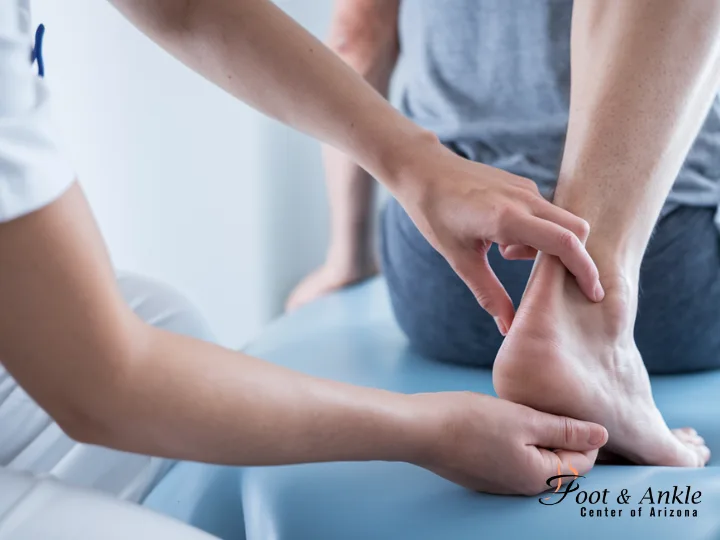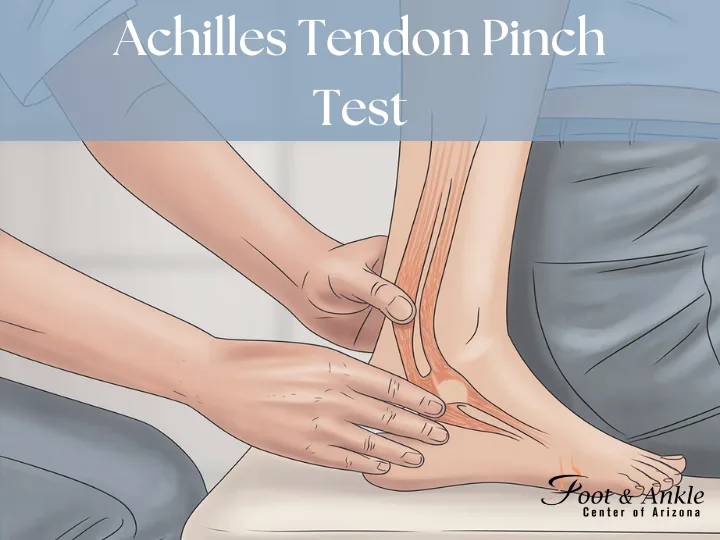1. Overview Achilles tendon
The Achilles tendon plays an important role in our lives, such as walking, running, and jumping. However, with great usage, it is prone to a great deal of injury and disorders, such as tendinitis and tears. One useful diagnostic tool in finding disorders with this tendon is the Achilles tendon pinch test, which is a simple diagnostic procedure that might indicate the first signs of tendon pathology, hence allowing the patient appropriate treatment on time. The following article will outline what the Achilles tendon pinch test is, how it is performed, and what it can reveal about Achilles tendon health.
2. The Role of the Achilles Tendon
The Achilles tendon is the largest in the body and the most powerful; it is connected by calf muscles with the heel bone. Therefore, it allows for different forms of activities that involve pushing the foot, such as jumping or even walking uphill. This functioning tendon is highly put under a considerable amount of stress and may thus be easily susceptible to overuse injuries and other complications. The Achilles tendon pinch test is one of the common modalities for detecting the signs that this vital structure is in danger so that the patient may take steps to preserve its health.
3. What is the Achilles Tendon Pinch Test? 
The Achilles tendon pinch test is an investigative process whereby the Achilles tendon is lightly pinched at different points. This simple test can locate the precise areas that are painful or tender, which may be indicative of inflammation, tears, or other conditions related to the tendons. Lightly pinching or pressing along the tendon, it is rather easily possible to notice tenderness or abnormalities; hence, the Achilles tendon pinch test is a good early-warning measure for Achilles tendon problems.
This test is of particular importance to physical therapists, sports medicine physicians, and podiatrists because it offers direct information on how to identify problems with tendons without the need for highly specialized equipment. If the suspicion should persist, the pinch test may indicate whether further imaging with ultrasound or MRI will be required.
4. How the Achilles Tendon Pinch Test is Conducted
The Achilles tendon pinch test is typically done by a trained healthcare professional in a clinical setting. Here’s a look at how the procedure unfolds:
Positioning:
Have the patient either sit or lie down in a comfortable position with the affected leg in a relaxed state to have better access to the Achilles tendon.
Identifying the Tendon:
The health professional locates the Achilles tendon, which is located at the back of the heel up the leg.
Applying Pressure:
In this, the provider pinches or presses along various points of the tendon using his fingers, measuring for any areas that might cause pain or tenderness. Patient feedback is considered very valuable at this stage.
Pain Assessment:
This can include tenderness or pain described by the patient, which would point to disorders that may involve tendinitis or degeneration of the tendons.
Each part of the Achilles tendon pinch test offers clues to the tendon’s condition, helping healthcare providers determine if additional tests or treatments are warranted.
5. Indications of a Positive Achilles Tendon Pinch Test
When a patient experiences pain or discomfort during the Achilles tendon pinch test, it is typically classified as a “positive” result. This may indicate one of several potential Achilles tendon issues:
Achilles Tendinitis:
Inflammation or soreness along the course of the tendon, usually from repetitive strain or overuse, may point to Achilles tendinitis.
Tendinosis:
Generally speaking, chronic pain or tenderness along the tendon may indicate tendinosis-a type of degeneration that occurs over time within the fibers of the tendon.
Partial Tear:
In this case, one may experience severe sharp pain that warrants immediate treatment.
A positive result on the Achilles tendon pinch test can prompt further diagnostic tests or a tailored treatment plan, depending on the severity of the condition.
6. Common Causes of Achilles Tendon Pain
An Achilles tendon pinch test may diagnose the tendon, but one main reason is to ascertain the reasons that cause the Achilles to hurt. The common ones contributing to this are:
Frequent High-Impact Activity:
Vigorous activities, particularly in sports, may lead to high stress on the Achilles tendon over time.
Poor footwear:
Wearing shoes that offer very little support can put additional stress on the tendon and is especially bad for a person with prolonged activity.
Age and Overuse:
Age and overuse result in tendons gradually losing their elasticity with age, thus turning out to be prone to a lot of injuries that could be identified with the Achilles tendon pinch test.
Knowing these causes, one will be able to take necessary precautions and protect the Achilles tendon from further damage.
7. Treatment Options for Achilles Tendon Pain
If the Heel spur Achilles Tendon Pinch Test indicates a problem, there are various treatment options available:
Non-Surgical Options:
Rest and Modified Activity:
Reduction of high-impact activities decreases stress on the tendon, thus facilitating healing.
Physical Therapy:
This involves therapists taking patients through exercises that could relieve pain by strengthening and stretching the Achilles tendon.
Supportive Footwear and Orthotics:
Wearing shoes that provide adequate support may ease the strain on the tendon.
Anti-inflammatory drugs:
Over-the-counter medications help treat inflammation and pain.
Surgical Intervention:
For significant tears or when non-surgical treatments are ineffective, surgery may be considered as a last resort.
The choice of treatment depends on the severity of the injury indicated by the Foot Achilles Tendon Pinch test and the individual’s lifestyle.
8. Preventive Measures for Achilles Tendon Health
Whereas the Achilles tendon pinch test becomes useful in identifying problems, it would be better to prevent injuries before they happen. Here are measures to prevent injury to the tendons:
Warm-Up and Stretching:
Proper warm-up and calf stretches minimize the chance of tendon injury.
Gradual Increase in Activity:
Avoid sudden increases in intensity or frequency of activities, especially highly active sports.
Comfortable Shoes:
Tightly fitted shoes prevent sudden overstretches that would result in the conditions identifiable by the Foot Achilles Tendon Pinch test, thus reducing tension on the tendon.
By observing the precautions above, one will have less chance of undergoing an Foot Achilles Tendon Pinch test someday.
9. When to Consult a Healthcare Provider
If the pain in your Achilles tendon persists, worsens, or limits your mobility, it would be best to seek a doctor’s opinion. Persistent pain, swelling, and limitation of walking may indicate a more serious injury. The Heel spur Achilles Tendon Pinch Test is a good start for diagnosis, but in some instances, further imaging may be required for an appropriate diagnosis. The earlier this problem is addressed, the less likely the possibility of having to resort to invasive treatments later on.
10. FAQ Section
What does the Achilles tendon pinch test detect?
It detects inflammation, tenderness, or abnormalities within the Achilles tendon.
Does the Achilles tendon pinch test hurt?
There could be slight pain during the testing, most of all if there is an injury, but the test could be soft
How frequently does an Achilles tendon pinch test be given to an athlete?
For high-impact sports athletes, periodic follow-up may be effective, especially if it is about tendon pain.
Can Achilles tendinitis be self-diagnosed?
While minor tendon pain may at times be diagnosed by the individual, it is always best to seek the advice of a medical professional for the proper diagnosis and course of treatment.
What are common symptoms of Achilles tendinitis?
Symptoms include pain or stiffness along the Achilles tendon, in the morning or after activity.
This article provides an overview of the Heel spur Achilles Tendon Pinch Test, its uses, and how it can help you maintain a healthy Achilles tendon.
10. Conclusion
The Achilles tendon pinch test is a quick and effective way to assess tendon health and detect potential issues early on. Whether you’re an athlete or simply someone experiencing discomfort in this area, the pinch test offers an initial step toward diagnosing and treating Achilles tendon problems. Incorporating good practices for tendon health, staying vigilant for signs of discomfort, and seeking early intervention can help maintain a healthy, active lifestyle.




